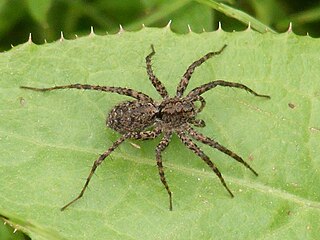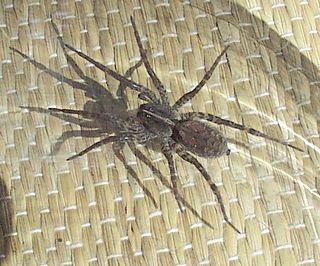
Wolf spiders are members of the family Lycosidae, from the Ancient Greek word "λύκος" meaning "wolf". They are robust and agile hunters with excellent eyesight. They live mostly in solitude and hunt alone, and do not spin webs. Some are opportunistic hunters pouncing upon prey as they find it or even chasing it over short distances. Some wait for passing prey in or near the mouth of a burrow.

Hogna is a genus of wolf spiders with more than 200 described species. It is found on all continents except Antarctica.
Hogna ingens, the Deserta Grande wolf spider, is a critically endangered spider species endemic to the Deserta Grande Island of the Madeira archipelago - specifically a remote valley, the Vale de Castanheira. Adult numbers have been estimated at less than 5,000, making it one of the rarest wolf spider species. It is also believed to be one of the largest wolf spiders on earth, with a 12 cm (4.7 in) leg span for the female, somewhat smaller for the male. Coloration is grey and black with white spots on the legs. The spider hides under rocks and crevices on this volcanic island, but its habitat is being invaded by the grass Phalaris aquatica, while the native vegetation is damaged by introduced goats and rabbits. The spider preys on smaller relatives, millipedes and other insects, and even small lizards. It is capable of delivering a painful and venomous bite to humans.

Tigrosa is a genus of spiders in the family Lycosidae, found in North America.

Hogna lenta is a species of wolf spider in the family Lycosidae. It is found in the USA.
Hogna baltimoriana is a species of wolf spider in the family Lycosidae. It is found in the USA and Canada.
Dictyna coloradensis is a species of mesh web weaver in the family of spiders known as Dictynidae. It is found in the United States.
Speranza coloradensis is a species of geometrid moth in the family Geometridae. It is found in North America.
Lichenomima coloradensis is a species of mouse-like barklouse in the family Myopsocidae. It is found in North America.
Sweltsa coloradensis, the Colorado sallfly, is a species of green stonefly in the family Chloroperlidae. It is found in North America.
Orodrassus coloradensis is a species of ground spider in the family Gnaphosidae. It is found in the United States and Canada.
Hogna antelucana is a species of wolf spider in the family Lycosidae. It is found in the United States.
Nebria coloradensis is a species of ground beetle in the family Carabidae. It is found in North America.
Boreus coloradensis is a species of snow scorpionfly in the family Boreidae. It is found in North America.
Thanatophilus coloradensis is a species of carrion beetle in the family Silphidae. It is found in North America.

Pardosa milvina, the shore spider, is a species in the wolf spider family. They are mainly found near rivers and in agricultural areas in eastern North America. P. milvina feed on a large variety of small insects and spiders. Ground beetles such as Scarites quadriceps and large wolf spiders such as Tigrosa helluo are predators of P. milvina. P. milvina are smaller spiders with thin, long legs. This species captures prey such as arthropods with their legs and then kills them with their venom. Their predators are larger wolf spiders and beetles. P. milvina are able to detect these predators from chemotactile and vibratory cues. These spiders lose limbs when escaping from predators and they can change their preferred location in order to avoid predators. P. milvina also use chemical cues in order to mate. During their mating ritual, the male raises his legs and shakes his body. Both males and females can use silk, a chemotactile cue, for sexual communication. Additionally, female shore spiders heavily invest in their offspring, keeping them in egg sacs and carrying them for a few weeks after they are born.

Hogna frondicola is a species of wolf spider in the family Lycosidae. It is found in the United States and Canada.
Pityohyphantes cristatus is a species of sheetweb spider in the family Linyphiidae. It is found in the United States.
Osmia coloradensis, the Colorado osmia, is a species of bee in the family Megachilidae. It is found in Central America and North America.
Mecaphesa coloradensis is a species of crab spider in the family Thomisidae. It is found in the United States and Mexico.





